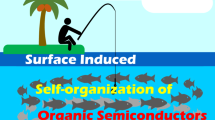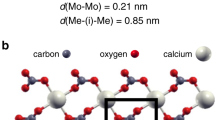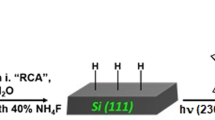Abstract
Self-assembled monolayers (SAMs) are widely used in a variety of emerging applications for surface modification of metals and oxides. Here, we demonstrate a new type of molecular self-assembly: the growth of organosilane SAMs at the surface of organic semiconductors. Remarkably, SAM growth results in a pronounced increase of the surface conductivity of organic materials, which can be very large for SAMs with a strong electron-withdrawing ability. For example, the conductivity induced by perfluorinated alkyl silanes in organic molecular crystals approaches 10−5 S per square, two orders of magnitude greater than the maximum conductivity typically achieved in organic field-effect transistors. The observed large electronic effect opens new opportunities for nanoscale surface functionalization of organic semiconductors with molecular self-assembly. In particular, SAM-induced conductivity shows sensitivity to different molecular species present in the environment, which makes this system very attractive for chemical sensing applications.
This is a preview of subscription content, access via your institution
Access options
Subscribe to this journal
Receive 12 print issues and online access
$259.00 per year
only $21.58 per issue
Buy this article
- Purchase on Springer Link
- Instant access to full article PDF
Prices may be subject to local taxes which are calculated during checkout






Similar content being viewed by others
References
Love, J. C., Estroff, L. A., Kriebel, J. K., Nuzzo, R. G. & Whitesides, G. M. Self-assembled monolayers of thiolates on metals as a form of nanotechnology. Chem. Rev. 105, 1103–1170 (2005).
Campbell, I. H. et al. Controlling charge injection in organic electronic devices using self-assembled monolayers. Appl. Phys. Lett. 71, 3528–3530 (1997).
Gundlach, D. J., Jia, L. & Jackson, T. N. Pentacene TFT with improved linear region characteristics using chemically modified source and drain electrodes. IEEE Electron. Dev. Lett. 22, 571–573 (2001).
Akkerman, H. B., Blom, P. W. M., de Leeuw, D. M. & de Boer, B. Towards molecular electronics with large-area molecular junctions. Nature 441, 69–72 (2006).
Heimel, G., Romaner, L., Brédas, J.-L. & Zojer, E. Interface energetics and level alignment at covalent metal–molecule junctions: π-conjugated thiols on gold. Phys. Rev. Lett. 96, 196806 (2006).
Briseno, A. L. et al. Patterning organic single-crystal transistor arrays. Nature 444, 913–917 (2006).
Kobayashi, S. et al. Control of carrier density by self-assembled monolayers in organic field-effect transistors. Nature Mater. 3, 317–322 (2004).
Takeya, J. et al. Effect of polarized organosilane self-assembled monolayers on organic single-crystal field-effect transistors. Appl. Phys. Lett. 85, 5078–5080 (2004).
Pernstich, K. P. et al. Threshold voltage shift in organic field effect transistors by dipole monolayers on the gate insulator. J. Appl. Phys. 96, 6431–6438 (2004).
Facchetti, A., Yoon, M.-H. & Marks, T. J. Gate dielectrics for organic field-effect transistors: new opportunities for organic electronics. Adv. Mater. 17, 1705–1725 (2005).
Chua, L. L. et al. General observation of n-type field-effect behaviour in organic semiconductors. Nature 434, 194–199 (2005).
Ong, B. S., Wu, Y., Liu, P. & Gardner, S. High-performance semiconducting polythiophenes for organic thin-film transistors. J. Am. Chem. Soc. 126, 3378–3379 (2004).
McCulloch, I. et al. Liquid-crystalline semiconducting polymers with high charge-carrier mobility. Nature Mater. 5, 328–333 (2006).
Payne, M. M. et al. Organic field-effect transistors from solution-deposited functionalized acenes with mobilities as high as 1 cm2/Vs. J. Am. Chem. Soc. 127, 4986–4987 (2005).
de Boer, R. W. I., Gershenson, M. E., Morpurgo, A. F. & Podzorov, V. Organic single-crystal field-effect transistors. Phys. Status Solidi 201, 1302–1331 (2004).
Gershenson, M. E., Podzorov, V. & Morpurgo, A. F. Colloquium: Electronic transport in single-crystal organic transistors. Rev. Mod. Phys. 78, 973–989 (2006).
de Boer, R. W. I., Iosad, N. N., Stassen, A. F., Klapwijk, T. M. & Morpurgo, A. F. Influence of the gate leakage current on the stability of organic single-crystal field-effect transistors. Appl. Phys. Lett. 86, 032103 (2005).
Hulea, I. N. et al. Tunable Fröhlich polarons in organic single-crystal transistors. Nature Mater. 5, 982–986 (2006).
Panzer, M. J. & Frisbie, C. D. High charge carrier densities and conductance maxima in single-crystal organic field-effect transistors with a polymer electrolyte gate dielectric. Appl. Phys. Lett. 88, 203504 (2006).
Lin, C.-H. & Radhakrishnan, K. Synthesis of anthracene ethers from anthracene methyl ethers via an acid-catalyzed exchange reaction. Chem. Commun. 4, 504–506 (2005).
Abe, Y. et al. Control of threshold voltage in pentacene thin-film transistors using carrier doping at the charge-transfer interface with organic acceptors. Appl. Phys. Lett. 87, 153506 (2005).
Maenning, B. et al. Controlled p-type doping of polycrystalline and amorphous organic layers: Self-consistent description of conductivity and field-effect mobility by a microscopic percolation model. Phys. Rev. B 64, 195208 (2001).
Nollau, A. Investigation of the Doping Process in Organic Molecular Thin Films. Thesis, Dresden Technical Univ. (2002).
Podzorov, V. et al. Interaction of organic surfaces with active species in the high-vacuum environment. Appl. Phys. Lett. 87, 093505 (2005).
Sugimura, H., Hayashi, K., Saito, N., Nakagiri, N. & Takai, O. Surface potential microscopy for organized molecular systems. Appl. Surf. Sci. 188, 403–410 (2002).
Sariciftci, N. S., Smilowitz, L., Heeger, A. J. & Wudl, F. Photoinduced electron transfer from a conducting polymer to buckminsterfullerene. Science 258, 1474–1476 (1992).
Lee, S. B. et al. Ground state charge transfer in fullerene–polyalkylthiophene composites: ESR and iodine doping effect. Synth. Met. 77, 155–159 (1996).
Marumoto, K., Kuroda, S., Takenobu, T. & Iwasa, Y. Spatial extent of wave functions of gate-induced hole carriers in pentacene field-effect devices as investigated by electron spin resonance. Phys. Rev. Lett. 97, 256603 (2006).
Sundar, V. C. et al. Elastomeric transistor stamps: Reversible probing of charge transport in organic crystals. Science 303, 1644–1646 (2004).
Podzorov, V. et al. Intrinsic charge transport on the surface of organic semiconductors. Phys. Rev. Lett. 93, 086602 (2004).
Podzorov, V., Pudalov, V. M. & Gershenson, M. E. Field-effect transistors on rubrene single crystals with parylene gate insulator. Appl. Phys. Lett. 82, 1739–1741 (2003).
Crone, B. et al. Electronic sensing of vapors with organic transistors. Appl. Phys. Lett. 78, 2229–2231 (2001).
Acknowledgements
We thank A. Zakhidov, J. E. Anthony, E. Garfunkel and Y. Chabal for helpful discussions and S.-W. Cheong and S. Park for technical assistance with AFM. This work has been supported by the NSF grants DMR-0405208 and ECS-0437932.
Author information
Authors and Affiliations
Corresponding author
Supplementary information
Supplementary Information
Supplementary information, supplementary table 1, supplementary figures 1-4 (PDF 861 kb)
Rights and permissions
About this article
Cite this article
Calhoun, M., Sanchez, J., Olaya, D. et al. Electronic functionalization of the surface of organic semiconductors with self-assembled monolayers. Nature Mater 7, 84–89 (2008). https://doi.org/10.1038/nmat2059
Received:
Accepted:
Published:
Issue Date:
DOI: https://doi.org/10.1038/nmat2059
This article is cited by
-
Environmentally stable and stretchable polymer electronics enabled by surface-tethered nanostructured molecular-level protection
Nature Nanotechnology (2023)
-
Site-specific chemical doping reveals electron atmospheres at the surfaces of organic semiconductor crystals
Nature Materials (2021)
-
Monolayer organic field-effect transistors
Science China Chemistry (2019)
-
Rotator side chains trigger cooperative transition for shape and function memory effect in organic semiconductors
Nature Communications (2018)
-
Ultra-high gain diffusion-driven organic transistor
Nature Communications (2016)



